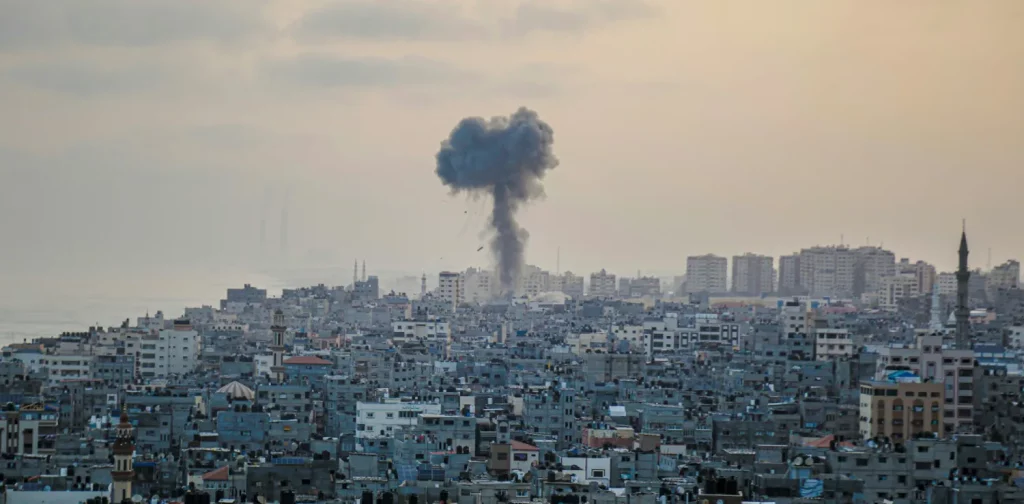Forgotten Victim: The Environmental Cost of Armed Conflicts

Gaza, Palestine. | Photo: Mohammed Ibrahim on Unsplash
Human lives are undoubtedly the main victims of conflicts. Unfortunately, the casualties extend to other aspects, such as the economy and culture. Then, there is another “victim” that usually goes unnoticed—the environmental cost of armed conflicts.
Did you know that the estimated emissions from the first 60 days of Israel’s attacks on Gaza in occupied Palestine exceeded the annual emissions from 20 countries and territories? This projection does not include the carbon footprint of the infrastructures built prior to this cycle of attacks beginning in October 2023. Moreover, greenhouse gas emissions alone do not cover the entirety of its cost to our planet.
Environmental Cost of Armed Conflicts
The complete scope of the environmental cost of armed conflicts is immense and long-lasting. It starts before the first shots are fired and lasts well beyond the last act of violence. Here are several ways armed conflicts impact the planet:
- Exploitation of Natural Resources
Armed conflicts involve weapons, ammunition, infrastructures, military vehicles, etc. During periods of preparation, the need for raw materials increases. This can lead to widespread deforestation and excessive mining activities. The exploitation of natural resources usually extends beyond the country border because these items are a lucrative part of international trade.
Furthermore, militaries require extensive land and sea areas for bases and training grounds. The making of these infrastructures often disrupts the ecosystems, and their usage causes further harm by releasing chemicals and pollutants from weapons and military vehicles.
- Greenhouse Gas Emissions
According to the Conflict and Environment Observatory (CEOBS), the militaries are responsible for 5.5% of all greenhouse gas emissions globally. This number might even be an underestimation due to the lack of transparency from militaries.
Among the largest sources of direct emissions from armed conflicts are fossil or diesel fuels to operate aircraft, naval ships, and tanks. There are also emissions from weapons discharged, such as missiles and bombs. Additionally, it is important to note that the carbon footprint of military activities comes not only from their direct emissions but also from the whole military supply chain.
- Biodiversity Decline
Animals, plants, and other biodiversity are also victims of armed conflicts. The destruction of their habitats leads to the deaths of many animals and plants. For instance, between 1946 and 2010, wildlife declined in African protected areas affected by armed conflict. In the oceans, marine animals suffer through naval exercises, with common pathologies being decompression sickness and acoustic traumas.
Violent attacks involving weapons are not the only threats to biodiversity. Starvation and displacement are among many issues that could lead to human-wildlife conflicts. In South Sudan, non-state armed groups, government forces, and even civilians are killing wild animals to survive as they grapple with famine.
- Long-Lasting Harm on the Ecosystems
The suffering doesn’t stop when the fighting does—this rings true for both people and the planet. The chemical waste and pollutants from armed conflicts linger in the environment long after they end, affecting nature and people who depend on it for generations to come.
For example, three decades after the Iran-Iraq war, a study identified elevated concentrations of toxic elements such as chromium, lead, and the semi-metal antimony in soils from the battlefields. Another instance is that after World War II, it was estimated that 40,000 tonnes of chemical munitions were dumped into the Baltic Sea. Researchers found traces of arsenic-containing agents and mustard gas products in sediment and fish near three weapon disposal sites.
Accountability, Enforcement, and Peace Building

As mentioned, militaries and defense forces and defense forces are not bound by international climate agreements to report or cut their carbon emissions. That is because military emissions were left out of the 1997 Kyoto Protocol on reducing greenhouse gasses and were excused again from the Paris Agreement in 2015. In fact, military and conflict emissions were formally discussed for the first time at the COP27 following the Russian invasion of Ukraine.
With the uptick of armed conflicts worldwide, strengthening international commitments and concrete actions on the ground to safeguard the environment in times of conflict is an urgent matter. This includes demanding transparency and accountability from militaristic bodies and defense forces.
Halting global warming and reducing emissions requires taking into account the environmental cost of armed conflicts. Of course, the environment shall not be the only focus in armed conflicts. Conflicts impact people, peace, prosperity, and the planet. A holistic approach that addresses all of them in peacebuilding efforts is crucial.
Peace is a prerequisite to development. So, tackling the root cause of armed conflicts is vital to stop the sufferings they cause for humans and nature alike and finally create space for sustainable development.

Join Green Network Asia Membership
Amidst today’s increasingly complex global challenges, equipping yourself, team, and communities with interdisciplinary and cross-sectoral insights on sustainability-related issues and sustainable development is no longer optional — it is a strategic necessity to stay ahead and stay relevant.
Join Now

 Weaving the Thread Between the Last Elephant and the Floods in Sumatra
Weaving the Thread Between the Last Elephant and the Floods in Sumatra  Prescribing Beyond Profit for CEOs’ Anxiety
Prescribing Beyond Profit for CEOs’ Anxiety  An Interview with May Tan-Mullins, CEO and Provost of University of Reading Malaysia
An Interview with May Tan-Mullins, CEO and Provost of University of Reading Malaysia  An Interview with Eu Chin Fen, CEO of Frasers Hospitality
An Interview with Eu Chin Fen, CEO of Frasers Hospitality  The UK Government’s Funding Package Plan to Tackle Youth Unemployment
The UK Government’s Funding Package Plan to Tackle Youth Unemployment  Understanding the Dark Side of Artificial Intelligence
Understanding the Dark Side of Artificial Intelligence